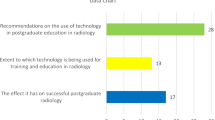Abstract
Purpose of review
This review explores opportunities and challenges in utilizing technology-mediated educational strategies for radiology education in parts of the world where attending radiologist support is limited. In efforts to increase the number of radiologists globally, radiology residencies have been established in regions where radiologists are scarce, several of which have partnerships with programs in other parts of the world. Technology-mediated educational strategies could leverage these partnerships to provide critical infrastructure to these recently established residencies.
Recent findings
The efficacies of strategies such as teleradiology and teleconferencing in global radiology have been evaluated, as have the effectiveness of technology-mediated educational tools in radiology. The topic of technology-mediated instruction for the newly established radiology residencies in other parts of the world has not yet been described or assessed, however.
Summary
Technology-mediated education has potential in the expanding realm of global radiology resident education, but there are some important constraints in the execution of these programs.
Similar content being viewed by others
References
Papers of particular interest, published recently, have been highlighted as: • Of importance •• Of major importance
Wong V, Smith AJ, Hawkins NJ, Kumar RK, Young N, Kyaw M, et al. Adaptive tutorials versus web-based resources in radiology: a mixed methods comparison of efficacy and student engagement. Acad Radiol. 2015;22(10):1299–307.
•• Sajedi P, Salamon N, Hostetter J, Karnezis S, Vijayasarathi A. Reshaping Radiology precall preparation: integrating a cloud-based PACS viewer into a flipped classroom model. Curr Probl Diagn Radiol. 2018. https://doi.org/10.1067/j.cpradiol.2018.07.014. This paper describes the strategy of flipping the classroom in radiology resident education.
Fefferman NR, Strubel NA, Prithiani C, Chakravarti S, Caprio M, Recht MP. Virtual radiology rounds: adding value in the digital era. Pediatr Radiol. 2016;46(12):1645–50.
Monteiro AM, Corrêa DG, Santos AA, Cavalcanti SA, Sakuno T, Filgueiras T, et al. Telemedicine and pediatric radiology: a new environment for training, learning, and interactive discussions. Telemed J e-Health. 2011;17(10):753–6.
• Sharpe EE, Kendrick M, Strickland C, Dodd GD. The radiology resident iPad toolbox: an educational and clinical tool for radiology residents. J Am Coll Radiol. 2013;10(7):527–32. This paper describes how the iPad was used to help organize a residency.
• Makary MS, Shah SH, Miller RJ, Doukides SP, King MA. Implementation of an innovative tablet-based curriculum for radiology resident education. Acad Radiol. 2018;25(12):1653–8. This paper also described how tablet computers were used to organize a residency curriculum.
The UGFacts Team. Mbarara University School of Medicine Radiology Department 2019. https://ugfacts.net/mbarara-university-school-medicine-radiology-department/.
University of Virgina. Educational Apps Help Radiology Residents in Uganda 2017. https://med.virginia.edu/radiology/2017/04/15/educational-apps-help-radiology-residents-in-uganda/.
Miniwatts Marketing Group. Internet World Stats 2018. https://www.internetworldstats.com/.
Trachtman L. For a Cloud PACS, how fast does my Internet access need to be? 2/4/2017. https://blog.purview.net/for-a-cloud-pacs-how-fast-does-my-internet-access-need-to-be.
Purview. Purview Speedtest 2019. http://upload.securerad.com/mini/?__hstc=38471612.919f00cad5f44930a46cbf33186c8402.1547387558981.1547387558981.1547387558981.1&__hssc=38471612.1.1547387558980&__hsfp=457898507&hsCtaTracking=2b973448-bb97-4b97-94cc-51edf0754470%7Cd7f7c4c6-3d31-43a2-82aa-358c852ab7ed.
Heany D. Internet data usage. 2017.
Author information
Authors and Affiliations
Corresponding author
Ethics declarations
Conflict of interest
Jennifer Lynn Nicholas declares no potential conflicts of interest.
Research Involving in Human and Animal Rights
This article does not contain any studies with human or animal subjects performed by any of the authors.
Additional information
Publisher's Note
Springer Nature remains neutral with regard to jurisdictional claims in published maps and institutional affiliations.
This article is part of the Topical collection on Global Radiology.
Rights and permissions
About this article
Cite this article
Nicholas, J.L. Technology-Mediated Education in Global Radiology: Opportunities and Challenges. Curr Radiol Rep 7, 13 (2019). https://doi.org/10.1007/s40134-019-0323-y
Published:
DOI: https://doi.org/10.1007/s40134-019-0323-y




